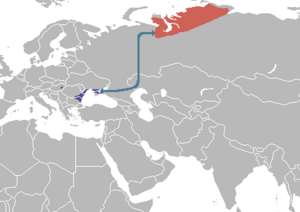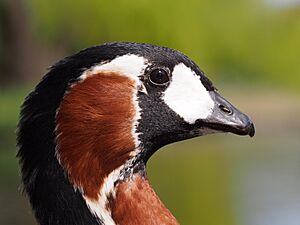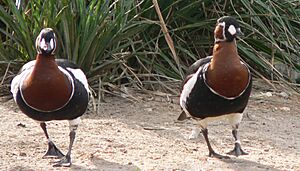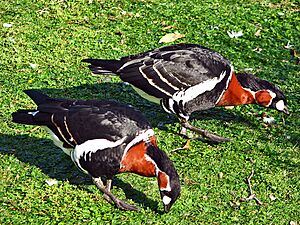Red-breasted goose facts for kids
Quick facts for kids Red-breasted goose |
|
|---|---|
 |
|
| Red-breasted goose at the Wildfowl & Wetlands Trust | |
| Conservation status | |
| Scientific classification | |
| Genus: |
Branta
|
| Species: |
ruficollis
|
 |
|
| Synonyms | |
|
Rufibrenta ruficollis |
|
The red-breasted goose (Branta ruficollis) is a very colorful type of goose. It lives in Eurasia, which is Europe and Asia combined. This special bird is currently listed as a vulnerable animal by the IUCN. This means its population is decreasing, and it needs our help to survive.
Contents
What's in a Name?
The red-breasted goose has a scientific name, Branta ruficollis. Scientists use these names to group animals together. The word Branta comes from an old Norse word meaning "burnt (black) goose." This refers to the dark color of these geese. The second part, ruficollis, comes from two Latin words: rufus meaning "red" and collis meaning "necked." So, its name literally means "red-necked black goose"!
Scientists sometimes thought this goose was so unique it should have its own group, Rufibrenta. But now, most experts agree it belongs with other geese in the Branta group. It's quite similar to the brant goose. Some studies even suggest the red-breasted goose might have come from a mix of two ancient goose types millions of years ago!
How to Spot a Red-breasted Goose
All geese in the Branta group are known for their dark, sooty colors with white markings. This helps tell them apart from the grey geese in the Anser group.
The red-breasted goose is the smallest of the Branta geese. It is about 53 to 56 centimeters (21 to 22 inches) long. Its bright colors make it stand out, but from far away, the red on its chest can look dark. This can make it tricky to spot if it's mixed in with other geese.
Where Do They Live?
Red-breasted geese breed, or have their babies, in the cold Arctic parts of Siberia. Their main breeding grounds are on the Taymyr Peninsula. Smaller groups can be found on the Gyda and Yamal peninsulas.
When winter comes, most of these geese fly south. They spend the colder months along the northwestern shores of the Black Sea. You can find them in countries like Bulgaria, Romania, and Ukraine. Sometimes, they fly even further southwest to Greece. Some also winter in Azerbaijan.
It's rare to see a red-breasted goose in places like Ireland or other parts of western Europe. However, many of these geese are kept in zoos or special bird collections. Sometimes, they escape and are seen outside their usual travel paths.
Long ago, many red-breasted geese used to winter in a place called Kirov Bay by the Caspian Sea. But in the 1960s, this area changed. Farmers started growing grapes and cotton instead of the grains the geese liked to eat. Luckily, the geese were able to find new places to spend the winter. They now go to suitable areas in Bulgaria and the Dobrogea region of Eastern Romania.
Behavior and Life Cycle
Red-breasted geese make a shrill, sharp call that sounds like "ki-kui" or "ki-yik."
These geese are quite small and shy. To stay safe, they often build their nests very close to the nests of large birds of prey. These birds include snowy owls, peregrine falcons, and rough-legged buzzards. This helps protect the geese from mammal predators like the Arctic fox. The closer a goose's nest is to a bird of prey's nest, the safer it usually is. It's very rare for the birds of prey to attack the geese.
Having more geese in a colony also makes them safer. This helps more geese survive and have their own babies. Besides nesting near birds of prey, red-breasted geese also build nests on islands in rivers. This protects them from predators that travel on land. However, they seem to prefer nesting near birds of prey even more than on river islands.
While the birds of prey often build their nests in open places, the geese hide their nests much better. A typical red-breasted goose colony has about 4 pairs of geese. This number can change depending on where the nest is, how much food is around, and how many birds of prey are nearby.
When a female goose is sitting on her eggs, she stays within about 1.5 kilometers (1 mile) of her nest. Male geese usually guard the nest from a distance, while the females stay hidden on the nest. The main predator for red-breasted goose eggs and young goslings is the Taimyr Gull. These gulls can reach nests located on river islands.
During winter, red-breasted geese eat grasses, leaves, and seeds. The number of owls and buzzards can change each year, depending on how many lemmings are available for them to eat. So, the most reliable protection for the geese comes from river islands and the peregrine falcon.
Protecting the Red-breasted Goose
In the autumn of 1997, there were about 88,000 red-breasted geese. By winter, this number could drop to around 70,000. The red-breasted goose is a species protected by an agreement called the Agreement on the Conservation of African-Eurasian Migratory Waterbirds (AEWA). This agreement helps monitor the species and provides information on its status, where it lives, its migrations, and what it needs to be conserved.
Even though the red-breasted goose is protected by law in many places, hunting still happens. More than 80% of the population spends winter at just five main locations. The feeding areas near these spots are at risk because of changes in how the land is used. There has been a big drop in their numbers over the last few decades. However, some scientists think this decline might be a bit too high, as some birds might be wintering in places we don't know about.
The places where the geese spend winter have changed a lot since the 1960s. Back then, many lived along the western coast of the Caspian Sea, in Iran, and Iraq. Now, some birds might be wintering further west. For example, in the winter of 2014, about 2,000 birds were counted in Hungary, while before only a few hundred were seen there.
Because it's not always clear how much the population of these geese changes, the red-breasted goose was moved from "Least Concern" to "Endangered" status on the IUCN Red List in 2007. This meant it was in much greater danger. However, in 2015, it was relisted as "Vulnerable."
People are working hard to protect these geese. From 2005 to 2008, a project funded by Life in Romania improved the habitat of an important saltwater lake used by the geese. In 2009, the Life Programme and AEWA held a meeting to create a new plan to help the species.
In 2011, bird experts from the Bulgarian Society for the Protection of Birds (BSPB) and the Wildfowl & Wetlands Trust started a project. They wanted to learn more about where the red-breasted geese travel. They put tiny GPS trackers on six geese. Now, they can track the geese using satellites. Scientists hope that learning about their migration paths will help them create better plans to protect the geese and their homes. Some recent counts have even shown a positive sign, with an increase in the goose population. This suggests there might be more than a fifty percent increase in their numbers.
However, there are still challenges. In February 2013, a Bulgarian court allowed a wind energy project to continue building wind turbines in an important wintering area for the geese. These turbines can be dangerous for the geese, as they might fly into them. Also, the construction takes away critical feeding grounds. An appeal was sent to the court to try and stop the project.







